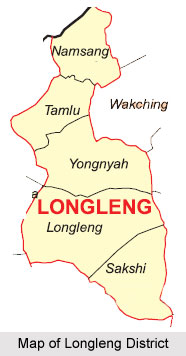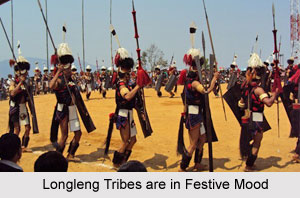 Longleng District is a region that occupies the elongated northern part of Nagaland State. Located at an altitude of the District varies from 150 Metres to 2000 Metres above the sea level, Longleng Town, the Headquarter of the district is around 1100 Metres above sea level.
Longleng District is a region that occupies the elongated northern part of Nagaland State. Located at an altitude of the District varies from 150 Metres to 2000 Metres above the sea level, Longleng Town, the Headquarter of the district is around 1100 Metres above sea level.
Geography of Longleng District
Longleng District has three district boundaries. On the East it shares boundary with Tuensang and Mon district of Nagaland and on the North it has Nagaland`s Inter-State boundary with Assam. On the west it shares boundary with Mokokchung District of Nagaland and on the south it shares boundary with Tuensang district of Nagaland. Longleng district enjoys monsoon type of climate with a minimum temperature of 10 øC in winter and a maximum of 28 øC in summer. The district has a fairly moderate climate where days are warm and nights are cool. Rainy season sets in during the month of May and lasts till October. From November to April, the District has dry weather relatively cool and days are bright and sunny. The average rainfall is between 2000mm and 3000mm. Tamlu and Longleng are the major towns in the district. Its main river is Dikhu.
 Economy of Longleng District
Economy of Longleng District
Rice is the stable food and agriculture is the main stay of the people of Longleng District. Jhum cultivation is the most common form of agriculture, though wet paddy cultivation is seen practiced by a few in recent times. Some of the agricultural products include rice, maize, varieties of vegetables, horticultural crops, etc. The low lying areas/Foothills of the District (bordering with Assam) is fertile and has the potential for wet paddy cultivation. Very few of the people are engaged in white collar jobs and majority of the people are agriculturists.
Demography of Longleng District
The population of the district is mainly tribe based. The Phom Nagas inhibit Longleng who are exceptionally good with pottery, spinning and bamboo work. Traditionally, the Phom Nagas have forayed into the occupation of agriculture. The origins of the Phoms can hardly be ascertained, but from oral tradition it can be deduced that this tribal group even emerged from the similar source as like the Ao Nagas. Phom Nagas have mostly converted into Christianity and thus have modernized to a large extent. However, during festivals they can still be found wearing Vihe-Ashak or Nempong-Ashak, which are shawls wrapped around the body. The Monyu Festival that is celebrated to herald the summers is celebrated with much pomp and fanfare. It also bids farewell to the winters. It is a six-day affair held during the month of April, right after sowing. Monyu is one of the main festivals of the Phom Nagas.



















